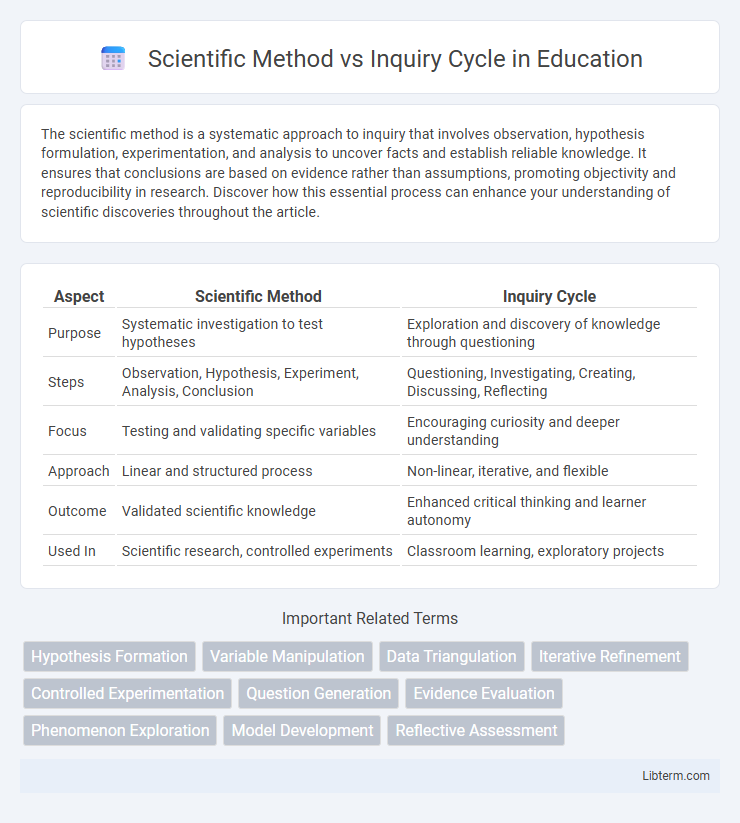The scientific method is a systematic approach to inquiry that involves observation, hypothesis formulation, experimentation, and analysis to uncover facts and establish reliable knowledge. It ensures that conclusions are based on evidence rather than assumptions, promoting objectivity and reproducibility in research. Discover how this essential process can enhance your understanding of scientific discoveries throughout the article.
Table of Comparison
| Aspect | Scientific Method | Inquiry Cycle |
|---|---|---|
| Purpose | Systematic investigation to test hypotheses | Exploration and discovery of knowledge through questioning |
| Steps | Observation, Hypothesis, Experiment, Analysis, Conclusion | Questioning, Investigating, Creating, Discussing, Reflecting |
| Focus | Testing and validating specific variables | Encouraging curiosity and deeper understanding |
| Approach | Linear and structured process | Non-linear, iterative, and flexible |
| Outcome | Validated scientific knowledge | Enhanced critical thinking and learner autonomy |
| Used In | Scientific research, controlled experiments | Classroom learning, exploratory projects |
Introduction to the Scientific Method
The Scientific Method is a systematic approach to research that involves formulating hypotheses, conducting experiments, and analyzing results to draw conclusions based on empirical evidence. It emphasizes controlled testing and reproducibility to validate scientific theories and knowledge. Understanding the Scientific Method provides a foundational framework for structured investigation, distinguishing it from the broader Inquiry Cycle, which includes more open-ended exploration and questioning.
Understanding the Inquiry Cycle
The Inquiry Cycle is a dynamic process emphasizing continuous questioning, exploration, and reflection to develop deep understanding and knowledge construction. Unlike the linear approach of the Scientific Method, the Inquiry Cycle encourages iterative investigation, embracing ambiguity and multiple perspectives as part of learning. This cyclical model supports critical thinking by integrating observation, hypothesis formation, experimentation, and evaluation in a flexible structure tailored to diverse educational contexts.
Key Stages of the Scientific Method
The key stages of the Scientific Method include observation, hypothesis formulation, experimentation, data analysis, and conclusion. Each stage systematically builds on the previous one to ensure empirical validation and reproducibility. Unlike the broader Inquiry Cycle, the Scientific Method emphasizes controlled experimentation as the cornerstone for testing specific hypotheses.
Core Phases of the Inquiry Cycle
The Inquiry Cycle centers on core phases such as questioning, investigating, creating, discussing, and reflecting, emphasizing iterative learning and critical thinking. Unlike the linear progression of the Scientific Method, the Inquiry Cycle promotes exploratory and student-driven processes that adapt dynamically to new information. This approach fosters deeper understanding through continuous engagement and synthesis of knowledge.
Historical Origins and Evolution
The Scientific Method traces its origins to the Renaissance period, with pioneers like Francis Bacon formalizing systematic observation and experimentation as foundations for knowledge. In contrast, the Inquiry Cycle evolved from educational theories in the 20th century, emphasizing iterative questioning, exploration, and reflection to foster deeper understanding. Both frameworks have influenced modern science education, integrating empirical rigor with dynamic investigation processes.
Comparison: Structure and Flexibility
The Scientific Method follows a rigid, linear structure with defined steps such as hypothesis formulation, experimentation, observation, and conclusion, ensuring systematic data validation. The Inquiry Cycle offers a more recursive and flexible framework that encourages iterative questioning, reflecting, and investigating, adapting dynamically to emerging information. Both frameworks aim to enhance understanding but differ significantly in their approach to process adaptability and methodological rigidity.
Application in Classroom and Research Settings
The Scientific Method emphasizes a linear process of hypothesis formulation, experimentation, observation, and conclusion, which facilitates structured classroom experiments and controlled research studies. The Inquiry Cycle promotes a recursive, student-centered exploration involving questioning, investigating, and reflecting, enhancing critical thinking and adaptability in both educational and research environments. Applying these frameworks enriches hands-on learning, data analysis, and fosters a deeper understanding of scientific concepts through iterative experimentation and evidence-based reasoning.
Advantages and Limitations of Each Approach
The Scientific Method offers a structured, hypothesis-driven framework ideal for testing specific predictions through controlled experiments, ensuring replicability and objectivity, yet may be limited by its rigid sequence and reliance on measurable variables. The Inquiry Cycle emphasizes iterative questioning and exploration, fostering creativity and adaptability in complex or ambiguous contexts but can lack the standardized rigor and clear conclusions typical of the Scientific Method. Both approaches complement each other by balancing systematic analysis with open-ended investigation, though choice depends on the nature of the problem and research goals.
Integrating Both Models in Education
Integrating the Scientific Method and Inquiry Cycle in education enhances critical thinking and promotes deeper student engagement by combining hypothesis-driven experimentation with open-ended exploration. Educators can design curricula that balance structured procedures of the Scientific Method with the flexible, student-centered questioning processes of the Inquiry Cycle. This hybrid approach cultivates scientific literacy and nurtures adaptive problem-solving skills essential for 21st-century learning environments.
Conclusion: Choosing the Right Framework
Choosing the right framework between the Scientific Method and the Inquiry Cycle depends on the research context and goals. The Scientific Method offers a structured, hypothesis-driven approach ideal for controlled experiments, while the Inquiry Cycle emphasizes iterative questioning and exploration suitable for open-ended investigations. Understanding these distinctions helps researchers draw more accurate conclusions and tailor their methodologies effectively.
Scientific Method Infographic

 libterm.com
libterm.com